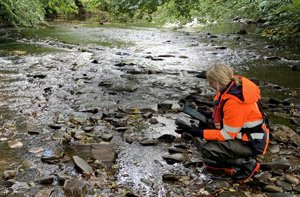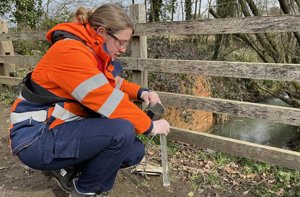
Water quality monitoring
We help organisations improve their impact on the environment through both planned and responsive water quality monitoring to evidence compliance with discharge permits or the impact of an uncontrolled discharge.
The aquatic environment is becoming increasingly vulnerable, with businesses that pollute their surrounding watercourses facing progressively heavier fines, reputational damage and even prosecution.
With only 14% of England’s rivers in good ecological health, the UK government has set a target of 75% of waterways reaching the single test of good ecological status by 2027 at the latest. Monitoring the quality of discharges and the receiving watercourse is essential if water quality is to be maintained and improved.
Demonstrating improvement
Our experts can design a bespoke water quality monitoring programme with sampling and analysis, interpretation of results with advice of compliance failures in a comprehensive report, and solutions for improving the quality of your effluent.
Our services include:
- Effluent discharge and environmental permit compliance monitoring.
- Monitoring of rivers and lakes for diffuse and point source pollution.
- High-level, catchment-wide nutrients investigations.
- Sampling the safety of bathing waters.
- Attending pollution incidents where water quality, wildlife or human health may be affected by contaminants.
24/7 response
Expertise
Capability
Equipment
Innovation
Our water quality consultants will take samples up and downstream of a discharge to monitor the record a number of key water quality indicators.
We take samples to assess the following:
- Chemistry – such as dissolved oxygen or ammonia.
- Biology – such as fish, macroinvertebrates, plant population.
- Hydrometry – how much water is present.
Water samples are measured against key parameters when analysed at UKAS ISO 17025 accredited laboratories.
Our experts employ a range of techniques to monitor water. These include:
- Spot sampling – This is where we use a bucket and chain to take a sample of water. This is sent to the lab to test for thousands of parameters. This method can be more accurate but is limited to one moment in time.
- In-situ field readings - This is where we use a bucket and chain to take a sample of water. We use a water quality meter to tell us the in-situ readings before the sample is sent to the lab. This is a good method to employ in a response, but parameter range is limited.
- Real-time telemetry – Here we position a sonde into the river with a data logger. A technician visits the site periodically to remove the sim card and retrieve the data. This method saves on the cost of continuous site visits, but means the results are less frequent.
- Telemetry sonde – Much the same as real-time telemetry we position a sonde into the river with a data logger. This data is automatically uploaded to a software platform which can include triggers and alarms when certain parameters are breached. This method is the most comprehensive and immediate, but it is also the costliest.
- Auto-sampler –machine sampling – battery powered pump, positioned in the field to draw water from the watercourse– the pump is set at the desired time frequency to draw water up through tubes and fill sample bottles.
Your environmental risk reduction partner, ensuring the safety of your people, property, reputation and the environment
Our experts are on hand to provide tailored investigation, consultancy, response and remediation services to help you balance commercial objectives and environmental compliance.
Contact our experts



